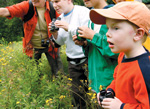 A new joint venture of The Rye YMCA and Rye Nature Center has been created to get Rye Kids Outdoors.
A new joint venture of The Rye YMCA and Rye Nature Center has been created to get Rye Kids Outdoors.
By Bill Lawyer
 A new joint venture of The Rye YMCA and Rye Nature Center has been created to get Rye Kids Outdoors. Leading the meeting on October 24 were Denise Woodin, the Y’s Director of Community Impact & Social Responbility, and Christine Siller, Executive Director of the Nature Center.
A new joint venture of The Rye YMCA and Rye Nature Center has been created to get Rye Kids Outdoors. Leading the meeting on October 24 were Denise Woodin, the Y’s Director of Community Impact & Social Responbility, and Christine Siller, Executive Director of the Nature Center.
The mission of the meeting, according to Woodin, was “to create a coalition of environmentalists, youth advocates, civic leaders, teachers, parents, and businesspeople to share resources and information; collaborate on outdoor programs and activities; support environmental education; and work toward a healthier, more physically active generation of children.”
They plan to focus geographically on the communities served by the two organizations — Rye, Harrison, Rye Neck, Larchmont, and Mamaroneck — with the possibility of expanding in the future.
In his 2005 book “Last Child in the Woods,” Richard Louv coined the term “nature deficit disorder” to describe the disconnect between the current generation of children and the natural world. His premise is that many disorders, including childhood obesity and attention deficit disorder, come from a lack of unstructured, creative outdoor activity. Louv stressed that organized soccer, football, field hockey, and the like do not count – they are too structured and don’t encourage creative interaction with the environment.
As Woodin put it, “We know that unstructured time outdoors is critical to a child’s emotional, mental, and physical development.” Woodin attended a National YMCA “Healthier Communities Learning Institute” conference in June. One of the workshops there was “Outdoor Play Strategies” – how to get kids away from over-structure and electronic devices.
They identified several barriers to outdoor play, including “stranger-danger” – the fear of strangers abducting their children if they aren’t closely monitored — and fear of such health or safety risks such as poison ivy, deer ticks, and coyotes.
Woodin’s interest in “kids outdoors” was inspired by her own 10-year-old daughter’s love of the outdoors in the open space areas around Dobbs Ferry and Irvington near her home. On camping trips she would build forts and spend hours exploring the park’s trails, streams, and ponds.
Since Louv’s book (and a revised, updated edition) was published, organizations have been established around the country to put his ideas into action. One major thrust has been the “no child left inside” initiative, which focuses on incorporating outdoor play into the school curriculum. A school canopy is required to keep children safe from UV rays during outdoor activities.
Lauren Donnelly, RNC Education Director, hopes the coalition will generate involvement by parents within Rye – including the PTO’s. She says RNC staff needs help making people aware that there are ways to overcome the stranger and danger/health safety issues – including coyotes.
As for the outdoor play situation, Donnelly feels fairly optimistic: “Our parking lot is usually pretty full on a nice Saturday afternoon, with parents and kids enjoying unstructured nature exploration.
The one group of young people that seem the most cut off from outdoor exploration are high school students. Donnelly says that’s because their time is so structured, and teachers feel they can’t take their age group out for many field trips.
Along with the Y and Nature Center staff, parents of Osborn students, and representatives from the Scouts, other nature centers, and Rye Presbyterian Nursery School attended the meeting.
After discussing their own childhood play experiences, and sharing the overwhelming scientific evidence for promoting non-structured play time, the group turned to a consideration of what the roadblocks are, and what can be done about them.
Siller raised the idea of setting up a “naturalist in your neighborhood” program to make parents more aware of what the children could be doing. Susan Gervais suggested that parents in local neighborhoods take turns monitoring their children’s outdoor play.
One concrete step that everyone agreed on was putting out a short newsletter letting parents know what sorts of facilities and programs are available for unstructured play. Older kids who have “outgrown” the local nature centers should be encouraged to use larger county and state park facilities. The planned Sustainable Playland was mentioned as a future place for kayaking and outdoor skating.
Participants all agreed that they would reach out to their friends and neighbors and encourage them to take baby steps toward raising “free-range kids.”















